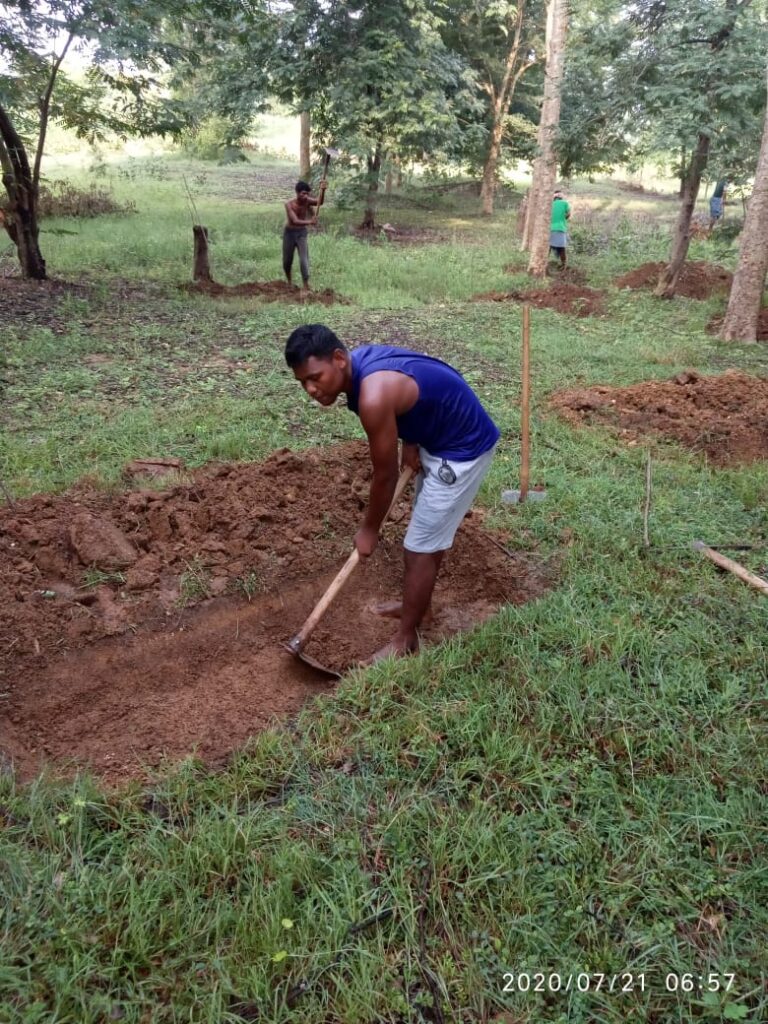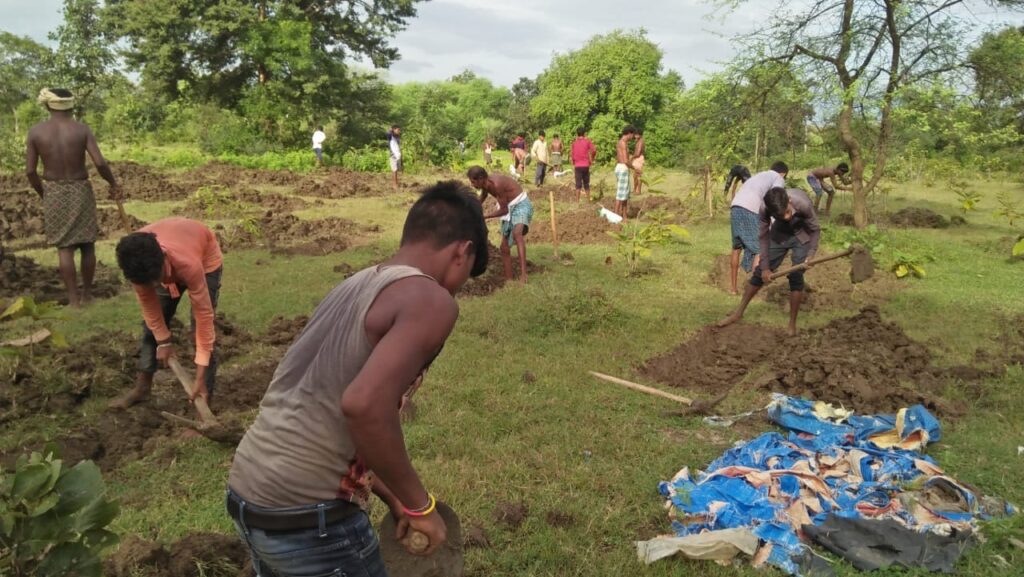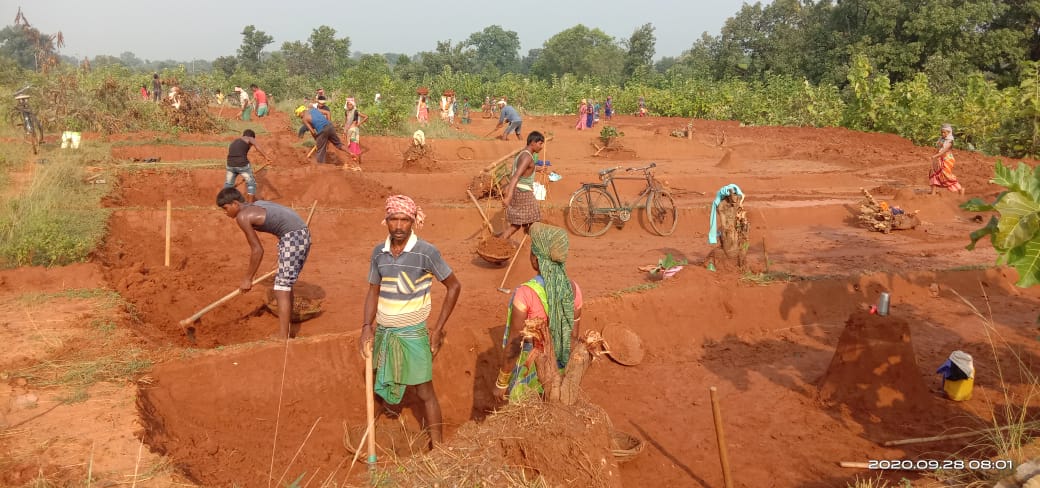Education did not come easy for 25-year-old Jadupati Biswal. His parents used to migrate for work to other states and he lost precious years of education. Finally, he managed to complete his graduation in his 20s, and was pursuing his second year post-graduation in the science stream from Kalinga Institute of Industrial Technology, formerly known as KIIT University, in Bhubaneswar, when COVID-19 struck. Today, he is a daily wager in Belpada block of Balangir district, Odisha, about 315 kilometres from the state capital Bhubaneswar. Under MGNREGA, he is digging a staggered trench to conserve water, having discontinued his studies during lockdown.
Biswal returned to his village following the nationwide COVID-19 lockdown in March. “I belong to a very poor family. My father is a marginal farmer and a daily wager, and he lost all earning opportunities due to the lockdown. We were in a severe financial crisis, and so I decided to take up MGNREGA work,” said Biswal.
The lockdown pushed many people in the low income group in rural areas into financial strain. What came to their rescue is the Mahatma Gandhi National Rural Employment Generation Act (MGNREGA). The works carried out under MGNREGA include pond and well digging, land development, constructing trenches and earthen bunds.
The scene is no different in Balangir district, and MGNREGA has allowed people a chance to earn a basic sustenance and keep their family afloat during the pandemic. For instance, Biswal did not find any job suitable for his educational qualification. Does he regret taking up MGNREGA work? “Not at all. I was sitting idle, and there was no other opportunity. At least through this, I am able to support my family financially,” he said.
Purandra Chhatriya of Kapani panchayat of Belpada block in Balangir district is 23 years old, and has been jobless for two years. He has qualified for the Odisha Teacher Eligibility Test (OTET) and completed a diploma in elementary education. He looked for teaching opportunities, but the lockdown made his search more difficult. Like Biswal, Chhatriya now earns a living doing work that comes through MGNREGA.

Hope for returning migrants
Returning migrants, who made their way back home during lockdown after great effort (some were forcefully held back in other states till completion of work), have also relied on MGNREGA to feed their families.
In western Odisha, marginalised and economically underprivileged people from Balangir, Kalahandi, Nuapada and Bargarh districts migrate to the southern states of the country to work in brick kilns. Every year, about 300,000 people migrate to Andhra Pradesh, Telangana and Tamil Nadu. Of these, half are from Balangir, and they work in brick kilns there.
Nakula Bag of Sagunbhadi village under Belpada panchayat, who is 37 years old, was among those who wanted to return home when lockdown was announced. But, he was forced to continue working, and lived like a semi-bonded labourer. “We were living under fear, and most of us wanted to return to our families. But, as we took an advance in Odisha and migrated to work in the brick kilns in the South, the owner and supervisor there forced us to complete work before leaving. Only when the local district administration intervened were most of us allowed to come home,” Bag said. Once he returned, there was no work to be found.
Jatin Patra, an activist working with migrant labourers in Balangir district through his organisation Adhikar, said the migration happens due to lack of work opportunity and “delayed payments”. “They take an advance from sahukars (money lenders) and work for them in other states for months to repay the debt. Some of the labourers have job cards and did work in the past under MGNREGA, but lost trust in it after delayed payment and preferred to migrate.”
This year, when the government decided to provide work under MGNREGA during the pandemic, the idea was to provide regular work and timely payment. “In the four migration-prone districts of Balangir, Kalahandi, Nuapada and Bargarh, villagers have 200 days of work with regular payments. Due to this, a number of labourers are opting to work under the scheme,” said Patra. In just Belpada block, around 12,000 labourers are working under MGNREGA through Adhikar.
Ghanshyam Bag, who is 49 years old, returned from a brick kiln in Telangana. He is from Raikhal village in Dhumagata panchayat. “Earlier, there was no work opportunity in our village, and we were forced to migrate and work under inhuman conditions. If I get the kind of work we are getting now under MGNREGA, I would prefer staying in my village in Odisha,” he said.

Equal wages for equal work
When the men migrated to work in brick kilns, they usually took their wives and children along. “There are many instances of workplace harassment and sexual assault on women and adolescent girls,” said Patra. Now, families help in MGNREGA work too. “If we can work in brick kilns, we can work under MGNREGA as well. At least, here there is no wage discrimination and children are not forced to work like on brick kilns. Single women also get to work and support their family,” said 39-year-old Kanchan Bag, of Kenkeba village under Madhyapur panchayat, a former migrant worker who now works under MGNREGA in Odisha.
“If we receive this amount of work, we will prefer staying back here. Our children will get an education and adolescent girls will not be harassed,” she said, with a smile.
Sustainable livelihood
The Balangir district administration has, from May to November 17 this year, generated seven million working days, and has a target of crossing 10 million working days this year. In 2019, this number for the entire calender year was six million working days. Till date, in the district, Maheswar Swain, Project Director, DRDA (District Rural Development Agency), Balangir, said that a little above Rs 226 crore has been spent towards MGNREGA work in the district. Almost 400,000 active workers have been engaged for about 20,000 projects, and they receive timely payments. About 15,000 families have completed 100 days of work, he added.
If more villagers work under this scheme, migration will be a choice, not a compulsion, many feel. “A sustainable livelihood will minimise distress migration to brick kiln sites,” explained Patra.
This article has been sourced from Charkha Features


















